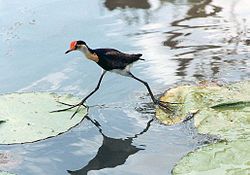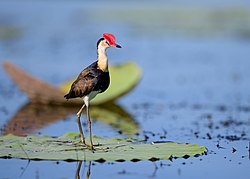Bird-life; a guide to the study of our common birds (1898) (14569022360)
Identifier: birdlifeguid00chap (find matches)
Title: Bird-life; a guide to the study of our common birds
Year: 1898 (1890s)
Authors: Chapman, Frank M. (Frank Michler), 1864-1945 Seton, Ernest Thompson, 1860-1946
Subjects: Birds
Publisher: New York, D. Appleton and company
Contributing Library: The Library of Congress
Digitizing Sponsor: The Library of Congress
View Book Page: Book Viewer
About This Book: Catalog Entry
View All Images: All Images From Book
Click here to view book online to see this illustration in context in a browseable online version of this book.
Text Appearing Before Image:
Fig. 9.—Wing of Woodcock, showing threeouter attenuate feathers. (y2 naturalsize.)
Text Appearing After Image:
Fig. 10.—Jacana, showing spur on wing (natural size) and elongated toes (V3natural size). gesture to the actual delivery of a blow is but a step.Swans, Pigeons, and Chickens can deal forcible blowswith their wings. Screamers, Lapwings, and Jacanas FORM AND HABIT: THE TAIL. 25 have formidable spurs on their wings, which they aresupposed to use in combat. The Tail.—Except when sexually developed, theshape of the tail is largely governed by the characterof its owners flight. Male Lyre-birds, Pheasants, Fowls,Hummingbirds, and many others furnish well-markedinstances of the tail as a sexual character. Indeed, asthe least important to the bird of the four externalorgans we are speaking of, the tail is more often sexuallymodified than any of the other three. The main office of the tail, however, is mechanical, toact as a rudder in flight and a balancer when perch-ing. Short-tailed birds generally fly in a straight course,and can not make sharp turns, while long-tailed birds canpursue a
Note About Images
Relevantní obrázky
Relevantní články
OstnákovitíOstnákovití (Jacanidae) je čeleď ptáků z řádů dlouhokřídlých (Charadriiformes), mezi jejíž hlavní znaky patří dlouhé nohy s extrémně prodlouženými prsty zakončené dlouhými drápy a rohovitý osten nebo hrbolek v ohbí křídla. Ostnáci se vyskytují v mělkých stojatých močálovitých vodách tropů a subtropů Jižní Ameriky, Asie, Austrálie a Afriky včetně Madagaskaru. Klíčový je pro ně výskyt vodní vegetace, po které se dokáží obratně pohybovat díky dlouhým prstům, které rozloží jejich váhu. Dosahují velikosti 15–58 cm a váhy 40–275 g. Opeření bývá různé, typicky zahrnuje skořicové a zelenavé barvy, občas je výrazná i bílá. Samice běžné bývají o 60 % větší než samci, u některých druhů dosahují až dvojnásobné váhy samců. Taková převrácená pohlavní dvojtvárnost je vůbec největší mezi všemi ptáky. .. pokračovat ve čtení
















